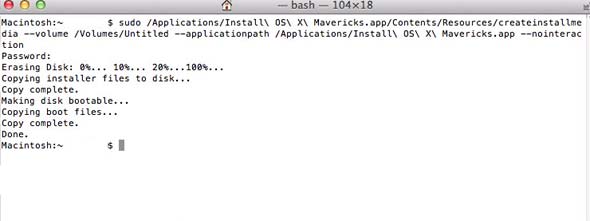

- #Make a bootable usb for mac os x mavericks software license
- #Make a bootable usb for mac os x mavericks install
- #Make a bootable usb for mac os x mavericks update
Go to the Mac App Store and redownload the "Install MacOS High Sierra" application. In order to make bootable USB of macOS high Sierra, you will need an 8gb or higher USB 2.
#Make a bootable usb for mac os x mavericks install
We have run the install program for T5 500 GB SSD on a MacBook High Sierra 10. It was working fine in sierra, something tells me this is an issue nvidia has to fix. my old 2010 Mid MacBook Pro MacOS Sierra 10.
#Make a bootable usb for mac os x mavericks update
Install High Sierra on RAID 0 Works! Hi, just to tell you that the clean installation and update on an iMac 11. This has frustrated a lot of the Mac community. 2: installation media - download high sierra from the App store - use Install Disk Creator - use Clover EFI bootloader and choose your usb as a target. And, yes we know High Sierra doesn't work with either APFS or GUID RAID boot volumes. Please do not ask questions regarding your specific problem in this thread. The latest version of Mac OS X High Sierra (10.
#Make a bootable usb for mac os x mavericks software license
“Agree” to the software license agreement. The app will be titled, “Install macOS High Sierra”. 13, follow any one of the below tips to fix the issue: macOS High Sierra 10. We are here to provide to clean and fast download for MacOS High Sierra 10. Could run the simulator and build to my phone running iOS. Choose the install disk and click ‘install’ (it won’t actually install yet!). Easily install Catalina, Mojave or High Sierra. Hello, does anyone have this kernel panic problem when using R8 with iMac Pro(10. 4 HFS+ Raid-0,trim enabled, very zippy indeed, boot times from power button to desktop took 33. Question: Q: Download original High Sierra 10. i've used SuperDuper to cloned Sierra 10. That's obviously a different scenario than what you have, but as the software RAID is handled at a higher level than the OS, I think you should be fine. When you are done, you’ll be directed back to the OS X Utilities dialogue.Install high sierra on raid 0 Step #3. You have selected the "Mac OS Extended (Journaled)" format.Ĭlick the Erase button button and everything (including files, applications, settings, etc) in your Mac will be completely You are selecting your Mac’s hard disk drive (and not your flash drive’s) on the left menu. Īt the Disk Utility screen, make sure you have these selected: Press the Option key / alt, and choose to boot from this drive ( Yosemite ). Type in your user password, when required, to start the process. : sudo /Applications/Install\ OS\ X\ Yosemite.app/Contents/Resources/createinstallmedia -volume /Volumes/Yosemite -applicationpath /Applications/Install\ OS\ X\ Yosemite.app - nointeraction : sudo /Applications/Install\ OS\ X\ Yosemite.app/Contents/Resources/createinstallmedia -volume /Volumes/Yosemite -applicationpath /Applications/Install\ OS\ X\ Yosemite.app Open Terminal (it is found in the same folder as the Disk Utility app). Choose GUID Partition Table as the partition scheme and choose OK This can be done from the Erase tab within the app make sure that there are no multiple partitions (turn to the Partition tab to verify and correct this). Using Disk Utility (it is found in Other under Launchpad),įormat the USB drive as Mac OS Extended (Journaled), and name it Yosemite.

Connect the USB drive ( 8 GB ) to your Mac.


 0 kommentar(er)
0 kommentar(er)
